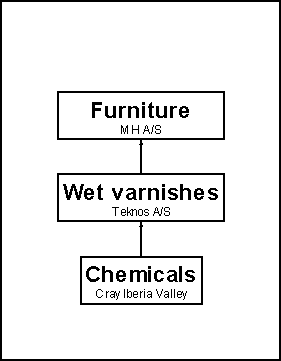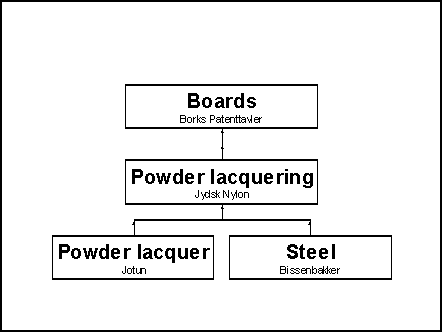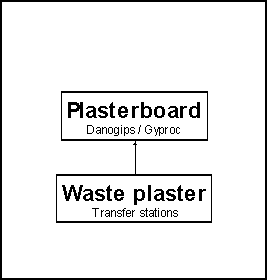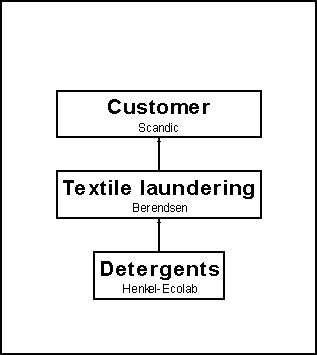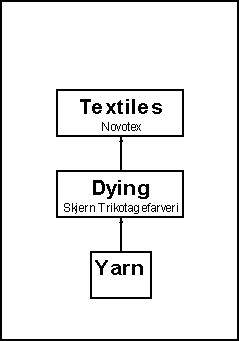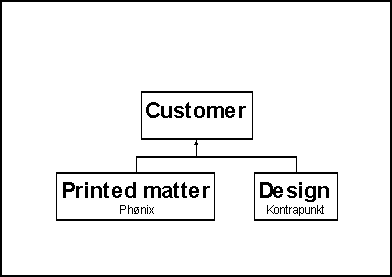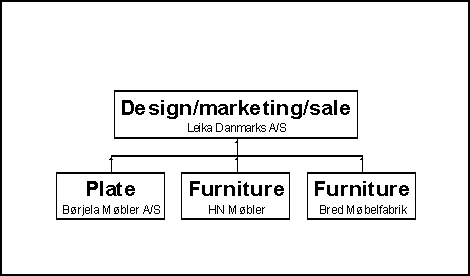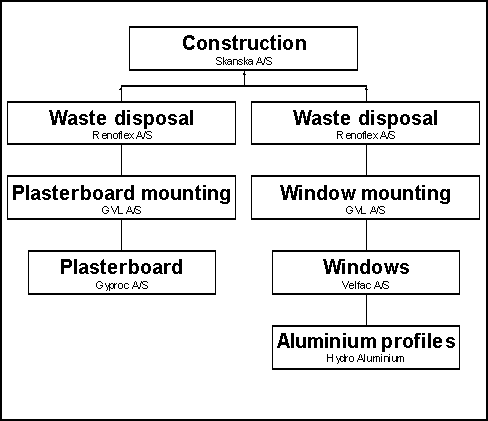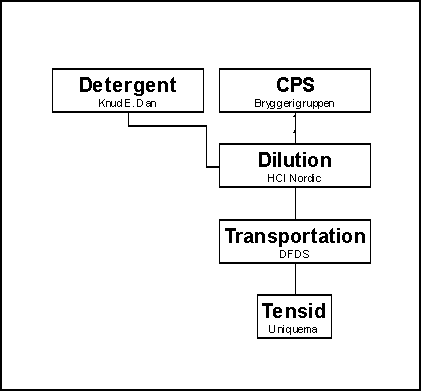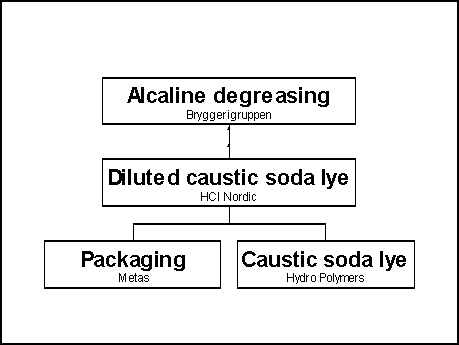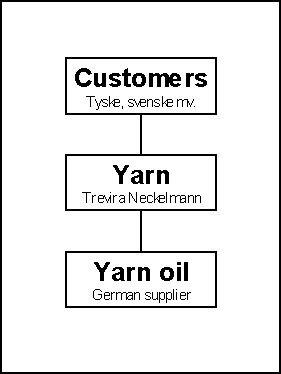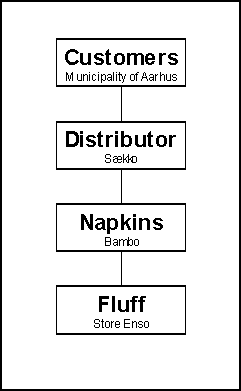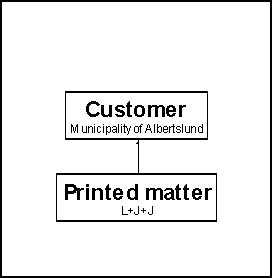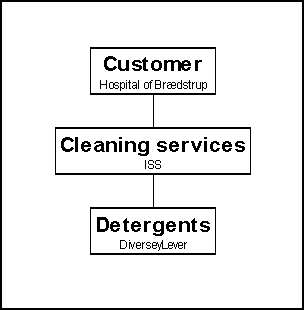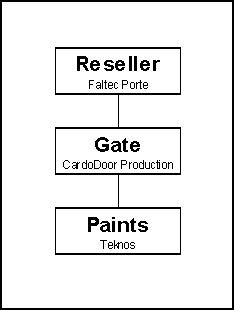Environmental Product Chain Management
2. The 25 product chains
Enterprise |
Manufacturer of wet varnishes and powder varnishes |
||||||||||||||||||||||||||
|
|||||||||||||||||||||||||||
Start phase |
The environment and quality manager saw some opportunities for the enterprise. The enterprise had worked previously with other environmental projects, including a large LCA project on a lacquer, so it had experience in the area. |
||||||||||||||||||||||||||
Product chain |
One customer (MH A/S – furniture manufacturer) and one supplier (Cray Iberia Valley – chemicals manufacturer) of Teknos A/S took part in the cooperation. They were chosen partly due to their interest in their own environmental issues and their interest in working with LCA, and partly due to personal relationships. A working group was established in each of the three enterprises, and a number of seminars were organised to build the necessary competence in connection with the preparation of an LCA for the selected lacquer as well as chairs and tables. On the basis of a wish expressed by MH Møbler the aim of the cooperation was to obtain a license for the Swan label for school furniture. |
||||||||||||||||||||||||||
Environmental cooperation |
Driving forces in the environmental cooperation:
Barriers to environmental cooperation:
|
||||||||||||||||||||||||||
Environmental achievements |
Possible environmental ’hot spots’ were identified in the different components in the product chain that could be subject to further scrutiny. In addition, cooperation among the enterprises was enhanced. |
||||||||||||||||||||||||||
Perspectives |
Teknos A/S sees enterprises manufacturing for the public market as potential partners for future cooperation. MH A/S wishes to establish corresponding cooperation with suppliers of wood and steel. Cray Iberia Valley does not want to be proactive, but will give positive response to future enquiries |
||||||||||||||||||||||||||
Remarks |
Customers set requirements in relation to the Danish Environmental Protection Agency’s purchasing guidelines |
||||||||||||||||||||||||||
Consultant |
COWI |
||||||||||||||||||||||||||
Enterprise |
Manufacturer of furniture fabrics |
||||||||||||||||||||||||||
|
|||||||||||||||||||||||||||
Start phase |
Based on an enquiry from a consultant Gabriel became interested in an LCA project, and an application for support to the project was submitted to the Danish Environmental Protection Agency. Gabriel was motivated partly as work took place as an integral part of their own environmental management system, partly due to customer requirements. |
||||||||||||||||||||||||||
Product chain |
Under the cooperation a number of sub-suppliers were to provide documentation for the preparation of the LCA: A dye and three surface-active substances were assessed in detail by a large chemicals supplier, and a supplier of woollen fabric provided data on environmental impacts in the manufacture of wool. In connection with the further work in the product chain sales staff of the enterprise supplied information on environmental issues to customers. According to Gabriel the environment is an important parameter among customers. Environmental issues are included in Gabriel quotations, and the enterprise sets requirements to own suppliers on full documentation. |
||||||||||||||||||||||||||
Environmental cooperation |
Driving forces in the environmental cooperation:
Barriers to the environmental cooperation:
|
||||||||||||||||||||||||||
Environmental achievements |
Gabriel A/S, in connection with the project, became aware that some of the dyes purchased contain lead, which led to requirements from Gabriel for substitution. In addition, Gabriel’s environmental cooperation with suppliers was formalised. |
||||||||||||||||||||||||||
Perspectives |
Due to customer demand for documentation on environmental issues, Gabriel will use the EU eco-label, the Flower. |
||||||||||||||||||||||||||
Remarks |
Gabriel sees a demand from customers in Norway, Sweden and Germany. When an environmental cooperation is started, often a closer cooperation is the result, which is an advantage in its own right. |
||||||||||||||||||||||||||
Consultant |
COWI |
||||||||||||||||||||||||||
Enterprise |
Carries out sand blasting, phosphating and lacquering |
||||||||||
|
|||||||||||
Start phase |
Jydsk Nylon experiences increased demand for information on environmental issues from customers (in particular foreign customers and in Denmark public purchasers). To handle this demand from customers a cooperation was started with two suppliers and a customer on coordination and communication of environmental information. Subsequently, support was applied for from the Environmental Competence Scheme. |
||||||||||
Product chain |
A product was chosen as a case for the development of a model for answering customer calls. An LCA screening of product components formed the basis for further work on communication of most essential environmental impacts from the product life-cycle. The cooperation among the four medium enterprises took place with consultant assistance. |
||||||||||
Environmental cooperation |
Driving forces in the environmental cooperation:
Barriers to the environmental cooperation:
|
||||||||||
Environmental achievements |
The environmental cooperation was not completed upon reporting of the example, and therefore it was not possible to take stock of direct environmental results. However, the cooperation has led to a closer relationship among the participating enterprises. Among others, to build up internal competence for the environmental cooperation Jydsk Nylon has introduced an ISO 14001-based environmental management system that has reduced environmental impacts from the enterprise itself, for example through a large reduction in electricity consumption and a significant drop in the consumption of trichloroethylene. |
||||||||||
Perspectives |
Jydsk Nylon intends to develop a website with product information to be used by customers and suppliers. |
||||||||||
Remarks |
|
||||||||||
Consultant |
COWI |
||||||||||
Enterprise |
Transport sector |
||||||||||||
Start phase |
Under Post Danmark’s efforts for open dialogue with customers one of the initiatives was an environmental assessment tool on Post Danmark’s website in order to be a frontrunner in the environmental field and as a reaction to customer’s demand for the environmental profile of the transport service. |
||||||||||||
Product chain |
Customers were given the possibility of calculating environmental impacts in the form of contributions of CO2, SO2 and NOx based on type of dispatch, whereas direct environmental impacts were not stated. Post Danmark found that it had a positive effect on customers, and at the same time Post Danmark was able easily to state environmental impacts in connection with tenders etc. This image had an impact on both customers and staff. |
||||||||||||
Environmental cooperation |
Driving forces
Barriers
|
||||||||||||
Environmental achievements |
Demands from customers enhance Post Danmark’s attention to its internal environmental issues |
||||||||||||
Perspectives |
|
||||||||||||
Remarks |
Often, customers demanded information on "something on the environment" without specifications. Post Danmark expected that it would push the enterprise more into the offensive if it was able to present an environmental profile. |
||||||||||||
Consultant |
COWI |
Enterprise |
Transport sector |
||||||||||||||||
Start phase |
The environmental cooperation is found primarily in connection with purchasing, as since 1992 DSB has had a policy on environmental considerations in purchasing. With the "Circular on green purchasing in public institutions" from the Ministry of the Environment (1996) DSB efforts on green purchasing were systematised through environmental requirements for suppliers. |
||||||||||||||||
Product chain |
Environmental requirements were prepared for purchasing in the form of minimum requirements, in some cases leading to a development cooperation with the supplier. DSB has worked systematically with an outline of chemicals consumption, and the policy has been prepared on the basis of the Danish Environmental Protection Agency’s list of undesired substances. Environmental requirements are used in tendering, evaluation of proposals and entering of framework contracts. |
||||||||||||||||
Environmental cooperation |
Tools:
Driving forces:
Barriers:
|
||||||||||||||||
Environmental achievements |
In the procurement of new S-trains LCA-screenings were made of different materials. For example, PVC flooring that was "the best choice" at first was replaced by artificial rubber, as PVC would cause problems upon waste disposal. Upon tendering of cleaning services two substances were identified as being problematic, and DSB entered into negotiations with the supplier on substitution. The supplier undertook product development, and phase-out of these substances within eight months from signature of the contract was set up as a precondition. A requirement for use of biodegradable lubricating grease was reconsidered after supplier reactions – the price was four times that of other greases. Based on new investigations DSB withdrew the requirement as after use the grease would be contaminated and have the same status as ordinary grease. In future, the biodegradable lubricating grease will be preferred, if prices go down. The results of DSB purchasing efforts are that the enterprise is in a position to comply with its own environmental requirements and, further, that supplier conscience on supply of environment-friendly services has increased. |
||||||||||||||||
Perspectives |
|
||||||||||||||||
Remarks |
Even if DSB would like to have suppliers setting requirements for sub-suppliers to improve the environmental profile of services, it is difficult to pass on the message. In reality, some suppliers refrain from submitting proposals for DSB assignments, as they are to demanding! DSB environmental efforts cannot be related to customer demand. |
||||||||||||||||
Consultant |
COWI |
Enterprise |
Manufacturer of plasterboard |
||||||||||
|
|||||||||||
Start phase |
For many years, Danogips has worked on a reduction of waste for landfilling from their own manufacture, and the enterprise has established a plant for recycling of production waste in new production. Further to a wish for returning demolished plasterboard from a large renovation project, Danogips took the initiative of developing a nationwide collection system for used plasterboard. The cooperation covered Danogips and Gyproc as well as two intermunicipal waste management companies. |
||||||||||
Product chain |
The cooperation led to a determination of common requirements for recyclable plasterboard at a detailed technical level. A geographic division of Denmark into west and east of the Great Belt was made, and in cooperation with the intermunicipal waste management companies a price for delivery of DKK200/tonne was agreed. However, local authorities assigning waste have only demonstrated very limited support. |
||||||||||
Environmental cooperation |
Driving forces
Barriers
|
||||||||||
Environmental achievements |
There has been poor backing of the take-back system, for example few municipal assignments of waste plaster. However, enterprises point out that positive experience has been gained from entering a formal environmental cooperation. |
||||||||||
Perspectives |
Danogips continues to work with the idea and has entered a cooperation with the demolition enterprise of Karsten Rasmussen on development of the collection system – primarily relating to logistics. The aim is to be able to collect also plaster covered with wallpaper or glass tissue, separating this and ensuring recycling of plaster. |
||||||||||
Remarks |
There may be a large need for external backing to support new systems. The results of the take-back system were limited by dependence of external parties (local authorities), having backed only to a very limited extent. |
||||||||||
Consultant |
COWI |
||||||||||
Enterprise |
Manufacture of frequency converters for regulation of electric motors |
||||||
Start phase |
Danfoss started with the establishment of a database on constituents in their components in 1996, since – as part of their environmental management system – they wished to take back end-of-life products for delivery to a recycling enterprise. However, this required more detailed product knowledge. At the same time, Danfoss had an enquiry from a large customer, Tetra-Pak, who, based on a construction products directive in Sweden wanted a declaration of a number of chemical constituents. Recognising that such enquiries from customers might become more common, Danfoss Drives spent rather many resources on establishing the database. |
||||||
Product chain |
In connection with the establishment of the database Danfoss Drives has collected information from suppliers on constituents in the components. With Danfoss Drives a dismantling guideline is prepared, stating how to dismantle and recycle the product at the end of its useful life. Knowledge of components has furthermore been used in Danfoss Drives to prepare a designers’ manual, ensuring consideration of environmental issues in the development of new products. |
||||||
Environmental cooperation |
Driving forces:
Barriers:
|
||||||
Environmental achievements |
Better knowledge of products has opened up for development of environment-friendlier products, and future requirements – for example in the EU WEEE directive(s) – will be complied with easier. |
||||||
Perspectives |
Suppliers in a longer-term perspective will have to fill in data themselves for components delivered to Danfoss Drives. Later, the database will be used for more genuine LCA assessment with Danfoss Drives. |
||||||
Remarks |
Even if the trigger was demands from a customer the enterprise does not meet many customer requirements relating to the environment – perhaps due to lack of competing enterprises? |
||||||
Consultant |
dk-TEKNIK ENERGY & ENVIRONMENT, DHI Water and Environment, Valør & Tinge |
Enterprise |
Manufacturer of cardboard packaging |
||||||||||
Start phase |
Hartmann, on the basis of life-cycle assessments, has established a database used, among other things for showing customers the environmental profile of a packaging, depending on the customers’ choice of colour, for example. This knowledge is used actively to enter into dialogue with customers on the environment in each individual sales situation. Brødrene Hartmann furthermore has developed a system for supplier assessment, in which suppliers through questionnaires assess their own position in relation to: networks, environmental management, cleaner technology, communication and training, and state their own most significant environmental impact. Furthermore, Hartmann purchasers have gone through a training course in the use of supplier assessments. Hartmann uses the tool for prioritisation of suppliers for dialogue, where suppliers with the largest "potential for improvement" are given most attention. |
||||||||||
Product chain |
The focal point of the cooperation is transfer of knowledge. Hartmann today holds data and knowledge resources that are superior to many others, due to their many years of experience in environmental optimisation, cleaner technology, environmental management and not least LCA. It is important to Hartmann to penetrate broadly into cooperator organisations so that they can enter into dialogue with the right decision-makers relating to the different environmental arguments. Hartmann presents environmental impacts from both own products and competitor products (primarily plastic packaging). Dialogue with customers is assumed by sales staff, communication and environmental specialists jointly, presenting both production, design, logistics and environment to customers. The task of Hartmann is mostly to train customers’ non-environmentally specialised staff groups. Key-account managers from all of Hartmann’s sales offices have joint meetings a number of times every year, and the environment is a permanent item on the agenda. |
||||||||||
Environmental cooperation |
The advantages of the environmental effort are:
|
||||||||||
Environmental achievements |
Through dialogue with suppliers and customers it is sought to give packaging better environmental profiles |
||||||||||
Perspectives |
Influence and "training" of customers is important to make them understand both environmental consequences of their choice, and how they can use the environment themselves as a competitive parameter, to gain internal benefits etc. |
||||||||||
Remarks |
|
||||||||||
Consultant |
dk-TEKNIK ENERGY & ENVIRONMENT, DHI Water and Environment, Valør & Tinge |
Enterprise |
Textile laundering |
||||||||
|
|||||||||
Start phase |
Berendsen and Henkel-Ecolab have entered a seven-year framework agreement for supply of chemicals and service to the laundries of Berendsen. One of the essential motivations for the cooperation is found in the Scandic Hotels, one of Berendsen’s large customers. Scandic (in Sweden) in 1994-95 requested that detergents complied with environmental requirements of the Swedish environmental label ’Bra Miljöval’. |
||||||||
Product chain |
Under the agreement Berendsen must buy detergents from Henkel-Ecolab and Henkel-Ecolab is committed to supply at competitive prices. Furthermore, Henkel-Ecolab must deliver dosing equipment for the Berendsen laundries. The cooperation covers for example: Optimisation and standardisation of laundering formulas and common objectives for environmental and health criteria for chemicals. |
||||||||
Environmental cooperation |
Driving forces:
Barriers:
|
||||||||
Environmental achievements |
The aim is to substitute substances with undesired properties in detergents. Results are summarised as
|
||||||||
Perspectives |
A development potential is found in the direct dialogue between Henkel-Ecolab and Scandic (today communicated through Berendsen), where, for example, a reduction in the amount of damp-stained textiles may reduce the use of bleaching agents. |
||||||||
Remarks |
Confidence among the enterprises is ensured with a seven-year agreement, and it is a precondition for obtaining knowledge of constituents from the chemicals supplier. |
||||||||
Consultant |
Dk-TEKNIK ENERGY & ENVIRONMENT, DHI Water and Environment, Valør & Tinge |
||||||||
Enterprise |
Manufacturer of coatings |
Start phase |
On the basis of attention from the media, Akzo Nobel Deco at its own initiative started work on substitution. |
Product chain |
Paints for professionals are divided into three categories:
These requirements are directed at substances evaporating during painting work and thus constituting a working environment problem, but not at substances that are problematic, for example, upon discharge into the aquatic environment. Akzo Nobel Deco in cooperation with, among others, Perstorp and P. Brøste has worked on substitution of an undesired group of substances (APEO) and, furthermore, in cooperation with the paints trade sought to develop paints that can be used by pregnant women (category a). It has been a precondition for the cooperation with raw material suppliers that there is confidence and confidentiality, since formulas for constituents are kept secret to competitors. |
Environmental cooperation |
Confidence among enterprises on confidentiality regarding formulas and constituents has been decisive for the cooperation. By focusing on substitution of individual substances there is a risk of them just being substituted by substances that may be just as problematic. Therefore, the cooperation has concentrated on avoiding undesired properties in the product instead of substitution of single substances. Attention from the media/customers/authorities is one of the reasons why Akzo Nobel wants to be an environmental frontrunner. Occupational health requirements from the paints trade are met through joint development cooperation. |
Environmental achievements |
Akzo Nobel Deco for the past five years has substituted more than 90% of the undesired group of substances APEO from their water-based paints. Contents of VOC, residual monomers etc. have been reduced currently in cooperation with the occupational health service for the paints trade. |
Perspectives |
Today, Akzo Nobel Deco seeks to be ahead of requirements/pressure from the media, authorities or customers through their "product stewardship" programme. The Akzo Nobel corporate management and Akzo Nobel Deco in cooperation determine environmental objectives within areas such as eco-labelling, classification for danger to the environment, reduction of VOC contents etc. Akzo Nobel Deco has a mutually beneficial cooperation with the occupational health service for the paints trade on development of paints to be used by pregnant women. |
Remarks |
Akzo Nobel focuses on undesired properties and have a target for the VOC contents of products, just as there are also objectives for products not needing labelling for danger etc. A requirement for suppliers on complete declaration of chemical products is considered as unrealistic, as constituents are the most important competitive parameter. |
Consultant |
Dk-TEKNIK ENERGY & ENVIRONMENT, DHI Water and Environment, Valør & Tinge |
Enterprise |
Manufacture of environment-friendly textiles |
||||
|
|||||
Start phase |
Skjern Trikotagefarveri (fabric dying) at a sales meeting at Novotex brought forward the idea of substituting formaldehyde in textile treatment. Novotex identified a Greek enterprise supplying yarn not requiring formaldehyde treatment. This triggered the manufacture of Novotex’ Green Cotton. Novotex now sets requirements for all suppliers, ensuring that Green Cotton products have an environmental advantage in all respects. |
||||
Product chain |
Novotex sets requirements for nine stages in the textile manufacture within five categories: Environmental management, life-cycle, communication, manufacture, product. The relationship with suppliers has developed in the process, from suppliers in the beginning being very willing to supply documentation and quoting good prices to have Novotex as a reference. Later, it became more difficult to get documentation, and Novotex has had to pay for some analyses. At the same time, the number of suppliers has increased as the product range has been extended. Novotex has concentrated on fewer suppliers and today has mainly Danish suppliers who respond to enquiries and follow developments more quickly. A need emerged for a PC tool for supplier assessment in this context. |
||||
Environmental cooperation |
It is Novotex’ experience that it is easier to set requirements for Danish suppliers than for foreign suppliers. In addition, it has been an advantage to have fewer suppliers, making Novotex a larger customer and thus facilitating requirement compliance. |
||||
Environmental achievements |
|
||||
Perspectives |
Novotex plans to develop other types of environment-friendly textiles (for example viscose, polyester etc.). Customers must be convinced of the value of eco-labelled clothes, and environment-friendliness must be extended to also cover ethical guidelines – staff management in the entire product chain. |
||||
Remarks |
Most Green Cotton products comply with criteria for eco-labelled textiles. |
||||
Consultant |
dk-TEKNIK ENERGY & ENVIRONMENT, DHI Water and Environment, Valør & Tinge |
||||
Enterprise |
Supply of designed, environment-friendly printed matter. |
||||||||
|
|||||||||
Start phase |
Kontrapunkt, a graphic design shop, wanting a printing shop with a good environmental profile, identified Phønix. This combination has ensured orders from large, environmentally conscious customers. |
||||||||
Product chain |
Kontrapunkt has set many difficult requirements, but Phønix was prepared to solve tasks in cooperation with Kontrapunkt. Printed matter complies with criteria for the Swan eco-label. Phønix got access to large customers through Kontrapunkt. Phønix is involved in the design phase to contribute with environmental knowledge. Both parties are also involved in sales work, and the enterprises make joint proposals for tenders. Today, more suppliers are able to deliver corresponding environment-friendly solutions, and therefore the competitive parameter in future will be "services". |
||||||||
Environmental cooperation |
Results:
|
||||||||
Environmental achievements |
|
||||||||
Perspectives |
|
||||||||
Remarks |
|
||||||||
Consultant |
dk-TEKNIK ENERGY & ENVIRONMENT, DHI Water and Environment, Valør & Tinge |
||||||||
Enterprise |
|||||||||||
|
|||||||||||
Start phase |
In cooperation with three furniture suppliers Leika Danmark A/S set up an objective of presenting a collection of eco-labelled (the Swan) furniture in the 2002 catalogue. All parties have given their consent, and Leika expects that work on documentation will be reduced once all suppliers can deliver Swan-labelled products. |
||||||||||
Product chain |
With support from an external consultant, enterprises cooperate on providing documentation and developing products, so that they can achieve the Swan label license. Suppliers get the Swan label license, whereas Leika owns the drawings for the furniture. |
||||||||||
Environmental cooperation |
Driving forces:
Barriers:
|
||||||||||
Environmental achievements |
Development of furniture collection complying with Swan label requirements |
||||||||||
Perspectives |
If the new furniture finds a satisfactory market the parties will probably develop more Swan labelled furniture. |
||||||||||
Remarks |
|
||||||||||
Consultant |
dk-TEKNIK ENERGY & ENVIRONMENT, DHI Water and Environment, Valør & Tinge |
||||||||||
Enterprise |
14. The Danish Centre for Resource Saving Concrete Manufacture and establishment of cement/concrete structures |
Start phase |
At the initiative of the Concrete division at the Danish Technological Institute the Danish Centre for Resource Saving Concrete was established. The centre is financed partially by the Danish Agency for Development of Trade and Industry. |
Product chain |
The purpose of the centre is to establish a platform for dialogue among the parties on development of environment-friendlier products. Suppliers, manufacturers, experts and purchasers of concrete are represented in the centre cooperation. A number of projects are carried out on, for example, design, material substitution, communication and the construction of a "Green Bridge". |
Environmental cooperation |
The parties expect that the Danish cement and concrete industry obtains an international competitive advantage through the cooperation. Aalborg Portland and Unicon experience increasing interest for environmental and occupational health issues, and they have a current dialogue with their suppliers on constituents. |
Environmental achievements |
Resource optimisation and substitution of environmental contaminants. Increased recycling of residual products. |
Perspectives |
The centre increases the opportunity for comprehension and dialogue on both technical and environmental problems in the product chain. Through the partial formalisation of the cooperation it becomes clear to participants, which opportunities are available to each single party for exerting an influence on his or her part of the product chain. This also increases the opportunities for joint influence. |
Remarks |
Aalborg Portland and Unicon cooperate with the European organisation for the cement and concrete sector on life-cycle analyses and with Nordic partners on a contribution to developing a concept for Nordic environmental product declarations. Knowledge gained through this work benefits the other enterprises in connection with assessments of possibilities for substitution and environmental consequences of substitution. |
Consultant |
dk-TEKNIK ENERGY & ENVIRONMENT, DHI Water and Environment, Valør & Tinge |
Enterprise |
Manufacturer of playground equipment |
||||||||||||||||||||
Start phase |
KOMPAN has an objective of reducing its environmental impact and improving the environmental profile of products. KOMPAN delivers to demanding markets and wishes to maintain and develop a high environmental profile. The enterprise therefore on several occasions has entered concrete cooperation with suppliers. KOMPAN has a policy of assessment of suppliers’ quality and environmental issues, however without specific objectives for the cooperation. |
||||||||||||||||||||
Product chain |
Suppliers are assessed on quality and environment. Strategic suppliers involved in the product chain analysis have delivered to KOMPAN for several years and have, for a number of years, cooperated on quality and reliability of delivery. In recent years, also environmental issues have been part of the cooperation. Suppliers’ production in many cases is planned for requirements for KOMPAN products, and thus there is a "mutual dependency". Cooperation between KOMPAN and suppliers takes its starting point in KOMPAN products, whereas from a narrow point of view there has not been focus on reducing suppliers’ environmental impact. KOMPAN expects that as a reaction to enquires for environmental issues, suppliers will develop in this field in their own right. |
||||||||||||||||||||
Environmental cooperation |
Driving forces:
|
||||||||||||||||||||
Environmental achievements |
|
||||||||||||||||||||
Perspectives |
The close cooperation opens up for assessing environmental issues relating to a product on a life-cycle basis – and focusing efforts where environmental perspectives are the largest. |
||||||||||||||||||||
Remarks |
|
||||||||||||||||||||
Consultant |
PlanMiljø |
||||||||||||||||||||
Enterprise |
Contractor |
||||||||
|
|||||||||
Start phase |
The Skanska Danmark A/S quality, environment and working environment system has three areas of effort: Waste, chemicals and energy. In addition to requirements for suppliers of products, Skanska also sets requirements for suppliers of services at construction sites, such as carpenters and waste haulers. |
||||||||
Product chain |
The standard conditions for cooperation with Skanska cover an environmental section dealing with:
Suppliers’ quality and environment plan must be approved by Skanska before work is started. Skanska has no fixed criteria for selection of suppliers, but in connection with selection it is described which criteria are included in the selection. For small suppliers guidelines are set up in preparation of quality and environment plans. |
||||||||
Environmental cooperation |
Driving forces:
Barriers:
|
||||||||
Environmental achievements |
|
||||||||
Perspectives |
Further environmental achievements can be reached by Skanska setting up simple objectives for selected, significant products, services and suppliers. |
||||||||
Remarks |
|
||||||||
Consultant |
PlanMiljø |
||||||||
Enterprise |
Distributor of chemical feedstock |
||||||||||
|
|||||||||||
Start phase |
In connection with, among other things, environmental requirements from a large supplier HCI Nordic has entered an environmental cooperation with suppliers and customers processing HCI semi-products. |
||||||||||
Product chain |
HCI’s objectives for the supplier/customer cooperation are:
There is much focus on handling of products, and HCI seeks to help customers in "correct" handling and use. |
||||||||||
Environmental cooperation |
Driving forces:
Barriers:
|
||||||||||
Environmental achievements |
|
||||||||||
Perspectives |
A prioritisation of environment work towards suppliers based on the principle of "more environment for the effort" may enhance the environmental benefit from the product chain cooperation. |
||||||||||
Remarks |
|
||||||||||
Consultant |
PlanMiljø |
||||||||||
Enterprise |
Manufacturer of concrete and porous concrete |
||||||||||||||||
Start phase |
The enterprise wishes to stand out as a frontrunner with development of sustainable production methods, and consequently it opted in on a project on development of environmental product declarations. The project took place in cooperation with other concrete manufacturers and was supported by the Danish Agency for Development of Trade and Industry and the Danish Environmental Protection Agency. Other concrete materials were well-documented, and the sector called for corresponding documentation for light clinker concrete. |
||||||||||||||||
Product chain |
The report describes H+H Fiboment’s work on the environmental product declaration that may be used in the long-term perspective as a basis for environmental cooperation in the product chain. |
||||||||||||||||
Environmental cooperation |
Driving forces:
Barriers:
|
||||||||||||||||
Environmental achievements |
Data have been compiled that may form the basis for the preparation of an environmental product declaration |
||||||||||||||||
Perspectives |
The environmental product declaration may be used in the selection of areas for effort in a product chain cooperation and as documentation to customers |
||||||||||||||||
Remarks |
|
||||||||||||||||
Consultant |
COWI |
Enterprise |
Processing and dying of textiles |
||||||||||||||||||
|
|||||||||||||||||||
Start phase |
Due to demands and requirements from customers Trevira Neckelmann became interested in developing a bio-oil for yarn processing. |
||||||||||||||||||
Product chain |
Trevira Neckelmann entered a cooperation with suppliers on development of an environment-friendly yarn oil complying with the following conditions:
Volvo set requirements for removal of NPE (washing agent) |
||||||||||||||||||
Environmental cooperation |
Driving forces:
Barriers:
|
||||||||||||||||||
Environmental achievements |
Today the enterprise can deliver an environmentally optimised product that is being further developed to live up to the Flower criteria. Thus, German, Swedish and Czech customers have been kept. In addition, building of knowledge with German sub-supplier. |
||||||||||||||||||
Perspectives |
Trevira Neckelmann is in contact with several possible cooperators on development of more environment-friendly products. |
||||||||||||||||||
Remarks |
Customer requirements have led to product development. Trevira does not find it decisive whether cooperators are Danish or foreign. Corporate culture is more important. |
||||||||||||||||||
Consultant |
COWI |
||||||||||||||||||
Enterprise |
Manufacture and sale of Swan-labelled napkins |
||||||||||||||
|
|||||||||||||||
Start phase |
In 1994 Bambo started manufacture of eco-labelled napkins in expectation of demand for such a product. |
||||||||||||||
Product chain |
From the manufacture of a paper product (fluff) for the napkins to the extension of the purchasing portal to also cover environmental issues focus was put on improvement of napkins’ environmental profile. Upon sale, guidelines are given for optimum use of napkins. Stora Enso delivers Swan-labelled fluff, whereas Sækko sells napkins to public customers. In connection with Bambo Swan label licenses the enterprise has entered a committing cooperation with Stora Enso on supply and technical and environmental product development. |
||||||||||||||
Environmental cooperation |
Driving forces:
Preconditions:
Barriers:
|
||||||||||||||
Environmental achievements |
Apart from the product improvement no result of the environmental cooperation is described. |
||||||||||||||
Perspectives |
Efforts are made to reduce the use of synthetics, improve exploitation of the wood resource, increase user-friendliness – for example in view of humidity indicators. |
||||||||||||||
Remarks |
Public purchasers with increased focus on environmentally optimised products play an important role as catalysts. Cooperation among the different links in the product chain is decisive for how easy it is to profile the product (provision of documentation etc.). Eco-labelling is not an unconditional success, when customers (particularly foreign) are not familiar with the labels. |
||||||||||||||
Consultant |
dk-TEKNIK ENERGY & ENVIRONMENT, DHI Water and Environment, Valør & Tinge |
||||||||||||||
Enterprise |
21. Levison+Johnson+Johnson A/S Printing shop |
||||||||||||||||
|
|||||||||||||||||
Start phase |
Levison+Johnson+Johnson sets high requirements relating to quality and the environment, and the enterprise in several cases has been the catalyst of customers making environment-friendlier choices in their purchase. |
||||||||||||||||
Product chain |
LJJ asked the Municipality of Albertslund to include environmental issues in their purchase of printed matter. The Municipality of Albertslund includes the environment to the same extent as price, quality and reliability of delivery in their purchase. For example, for printing jobs, the municipality only invites for tender environmentally certified printing shops having an eco-label license. LJJ’s environmental manager is often in direct dialogue with suppliers on environmental issues. |
||||||||||||||||
Environmental cooperation |
Driving forces:
Disadvantages of the Swan label:
|
||||||||||||||||
Environmental achievements |
Environmental achievements have not been quantified, but Swan-labelled printed matter guarantees that environmental impacts do not exceed a certain level per unit. |
||||||||||||||||
Perspectives |
LJJ wishes to further develop their sales work to have customers making environment-friendlier choices. For example, it is being considered whether the Swan label should be standard on printed matter unless customers reject it. |
||||||||||||||||
Remarks |
|
||||||||||||||||
Consultant |
dk-TEKNIK ENERGY & ENVIRONMENT, DHI Water and Environment, Valør & Tinge |
||||||||||||||||
Enterprise |
Cleaning contractors |
||||||||||
|
|||||||||||
Start phase |
DiverseyLever and ISS since 1997 have cooperated on cleaning solutions optimised in terms of the environment and quality. Formalised cooperation on cleaning systems deals with the environment, quality, ergonomics and financial issues. |
||||||||||
Product chain |
ISS and DiverseyLever has a strategic cooperation agreement worldwide, and enterprises in Denmark and the Nordic countries cooperate on having the Swan-labelled Nordic Line products included in the global product catalogue of ISS. Eco-labelled products thus may be spread to the further global cleaning activities of ISS. A substantial part of environmental impacts from cleaning activities is found with the final customer, so environmental management in this link is essential. |
||||||||||
Environmental cooperation |
Driving forces:
Barriers:
The turnover fee on the Swan label (0.4%) is a strain for DiverseyLever, and as a consequence the enterprise only has one Swan-labelled product in each product group, even if more products could actually be labelled |
||||||||||
Environmental achievements |
ISS in a special environmental effort at the hospital of Brædstrup has reduced water consumption by 70%, halved chemicals consumption and reduced waste arisings from cleaning to one third. Swan-labelled products are on the increase in the global ISS group. |
||||||||||
Perspectives |
Development of the Nordic product series may be used for a more environment-friendly development on other markets. DiverseyLever and ISS can enhance the product chain cooperation in future through systematic formulation of targets and plans of action with their cleaning service customers. |
||||||||||
Remarks |
Global groups may extend environment-friendly products across borders through harmonised product ranges. |
||||||||||
Consultant |
dk-TEKNIK ENERGY & ENVIRONMENT, DHI Water and Environment, Valør & Tinge |
||||||||||
Enterprise |
Environmental product declaration for gate |
|
|
Start phase |
The report describes the background for preparing an environmental product declaration in a dialogue among three enterprises. |
Product chain |
The report is a pilot project for development of an environmental product declaration for a gate. The example demonstrates how to handle an environmental product declaration so that the manufacturer is enabled to compare different products from suppliers and thus assess his own environmental impact. At the same time communication of information to the next link in the chain is made possible. If everybody follows the same standard for declaration it is easier for parties to compare and communicate product properties. |
Environmental cooperation |
Teknos’ experience with the EDIP PC tool is that it is not possible to compile sufficient data and thus to make a complete environmental product declaration of products. This is particularly problematic in the chemical industry, where constituents and processes are kept secret from competitors (Example from Teknos with data collection through the EDIP PC tool gave 3-10% of necessary data). It has proved considerably easier to work with the Swan label, setting limits in relation to specific environmental impacts. |
Environmental achievements |
|
Perspectives |
Declaration of gates primarily will deal with use of solvents and undesired substances in paints, as well as waste management. Gates are made from aluminium, iron, plastic and insulation material. There is no eco-labelling available, and to find relevant criteria the starting point has been taken in criteria for the Swan and the Flower and in the list of undesired substances. |
Remarks |
|
Consultant |
PlanEnergi |
Enterprise |
Service and trade within graphic and pharmaceutical industries |
||||||||||||||||||||||
Start phase |
DAN-RENS has drawn up a purchasing policy where all products are assessed in view of environment, working environment, financial issues and technique. In continuation of this DAN-RENS wishes to create a dialogue with their suppliers. |
||||||||||||||||||||||
Product chain |
The enterprise focuses on logistics and optimised haulage, for example on take-back of chemicals from customers. Customers get response on their ability to separate waste and on annual waste arisings. |
||||||||||||||||||||||
Environmental cooperation |
Driving forces:
Barriers:
|
||||||||||||||||||||||
Environmental achievements |
|
||||||||||||||||||||||
Perspectives |
|
||||||||||||||||||||||
Remarks |
|
||||||||||||||||||||||
Consultant |
FORCE Instituttet |
Enterprise |
Manufactures plastic film for the packaging industry |
||||||||
Start phase |
Starting point in the environmental management system of the enterprise |
||||||||
Product chain |
SKY-LIGHT has formalised an environmental dialogue with customers and plastic recycling enterprises. |
||||||||
Environmental cooperation |
Barriers:
|
||||||||
Environmental achievements |
|
||||||||
Perspectives |
To a large extent, further work takes its starting point in customer satisfaction surveys. |
||||||||
Remarks |
|
||||||||
Consultant |
FORCE Instituttet |
